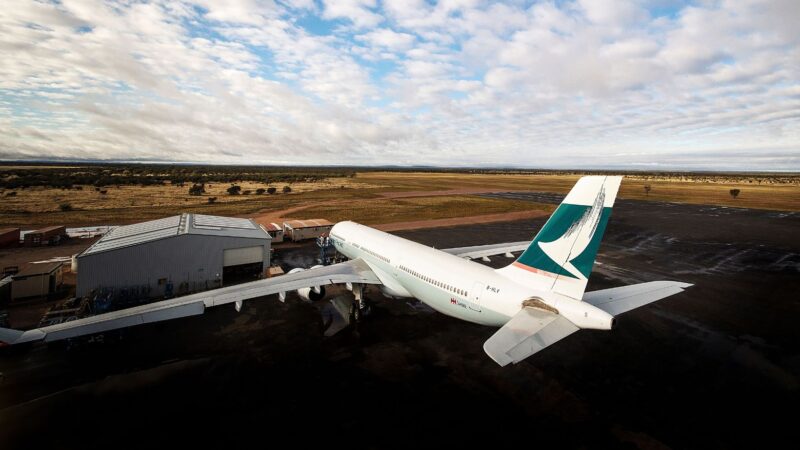Cathay’s last long-term parked aircraft returns for extensive maintenance
The Cathay Group has ‘reactivated’ its 85th and final aircraft that had been parked overseas long-term due to the Covid-19 pandemic.
After nearly four years in the Australian desert, Cathay Pacific’s Airbus A330 (registration B-HLV) returned to Hong Kong, where it will now undergo an extensive hangar maintenance check.
The aircraft was the first in the Cathay Group’s fleet to go into long-term parking overseas on July 28, 2020, as global air travel came to a near-standstill during the pandemic.
At the height of the pandemic, Cathay Pacific and HK Express parked the majority of their passenger fleet at Hong Kong International Airport, Alice Springs, Australia, and Ciudad Real, Spain.
As the pandemic began to subside, the Cathay Group started to progressively reactivate the aircraft which involved carrying out a rigorous series of maintenance checks and inspections to ensure safety and performance.
“A phenomenal achievement”
Alex McGowan, Cathay Group’s chief operations and service delivery officer, said: “An incredible amount of work goes into keeping an aircraft safe and protected when it isn’t flying, and to then reactivate it for entry back into regular service.
“To do this for more than 85 aircraft long-term parked overseas, as well as to manage the large number of aircraft that were parked in Hong Kong, is a phenomenal achievement.”
The Cathay Group has more than 70 new aircraft on order, with the right to acquire an additional 52 aircraft in the future.
McGowan added: “We are also exploring options for a new mid-size widebody aircraft.
These investments reflect our ongoing confidence in the Hong Kong international aviation hub as we look ahead to the exciting opportunities presented by the Three-Runway System at Hong Kong International Airport when it is fully commissioned by the end of this year.”
Bob Taylor, Cathay Group’s general manager of engineering operations, said: “An aircraft that is in long-term parking requires a defined programme of maintenance checks and inspections that are repeated over a regular cycle to ensure it’s preserved in tip-top condition.
“When it comes to reactivating the aircraft, a rigorous series of checks and inspections must first be accomplished to ensure the aircraft is safe to ferry back from its overseas parking facility.
“The aircraft then needs to undergo a further series of detailed checks and inspections as part of its scheduled hangar maintenance check.”
Periodic inspections and checks
Cathay claims that each aircraft that was long-term parked in Alice Springs underwent a 14-day preservation check when it first arrived, which was then followed by a repeating series of periodic inspections and checks.
Over the course of the parking programme in Alice Springs, more than 16,000 periodic checks were performed, and a total of 800,000 labour hours were spent performing preservation, periodic and reactivation maintenance.
Furthermore, over 40,000 parts and items of specialised equipment were also shipped from Hong Kong to support the Alice Springs operation.
Meanwhile, Cathay Group states that its onsite quality assurance team conducted more than 2,000 audits.
Taylor added: “It was truly a team effort that required the support of many departments within the airline as well as key partners including Hong Kong Aircraft Engineering Company (HAECO), Boeing and Airbus, and the local service provider in Alice Springs, Asia Pacific Aircraft Storage (APAS).
“To manage this body of work across an unprecedented number of aircraft was an incredible achievement by the team, of which I am immensely proud.”
READ MORE NEWS: Cathay Pacific launches new Premium Economy cabin

